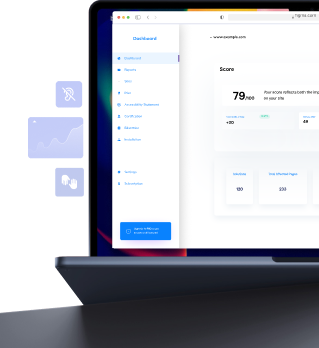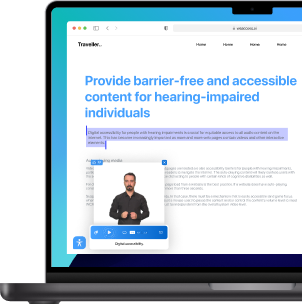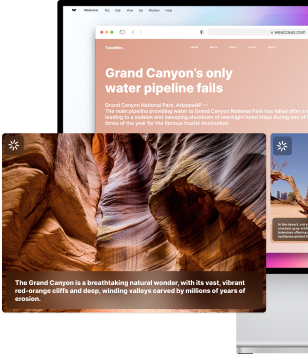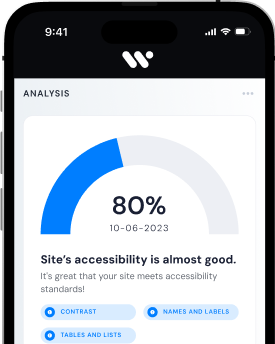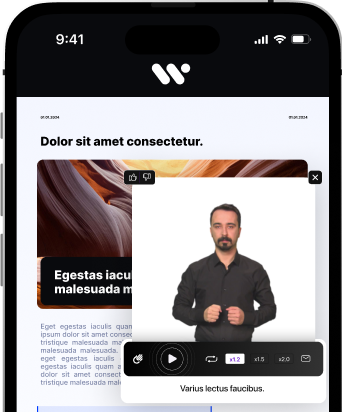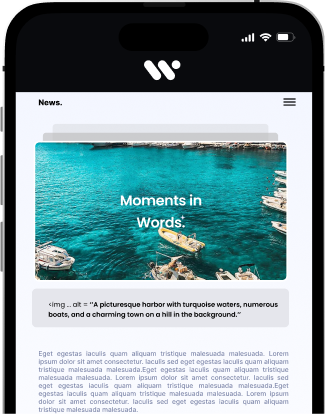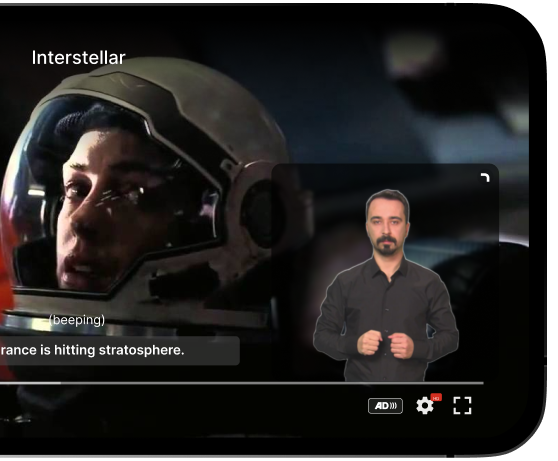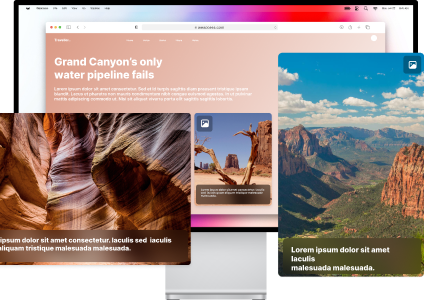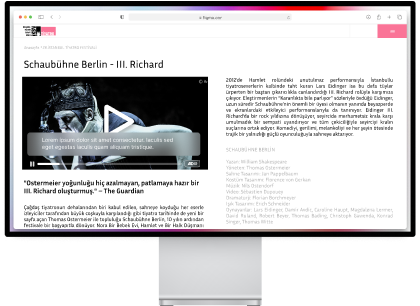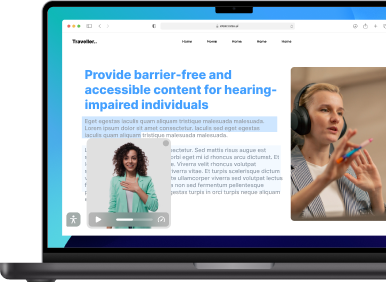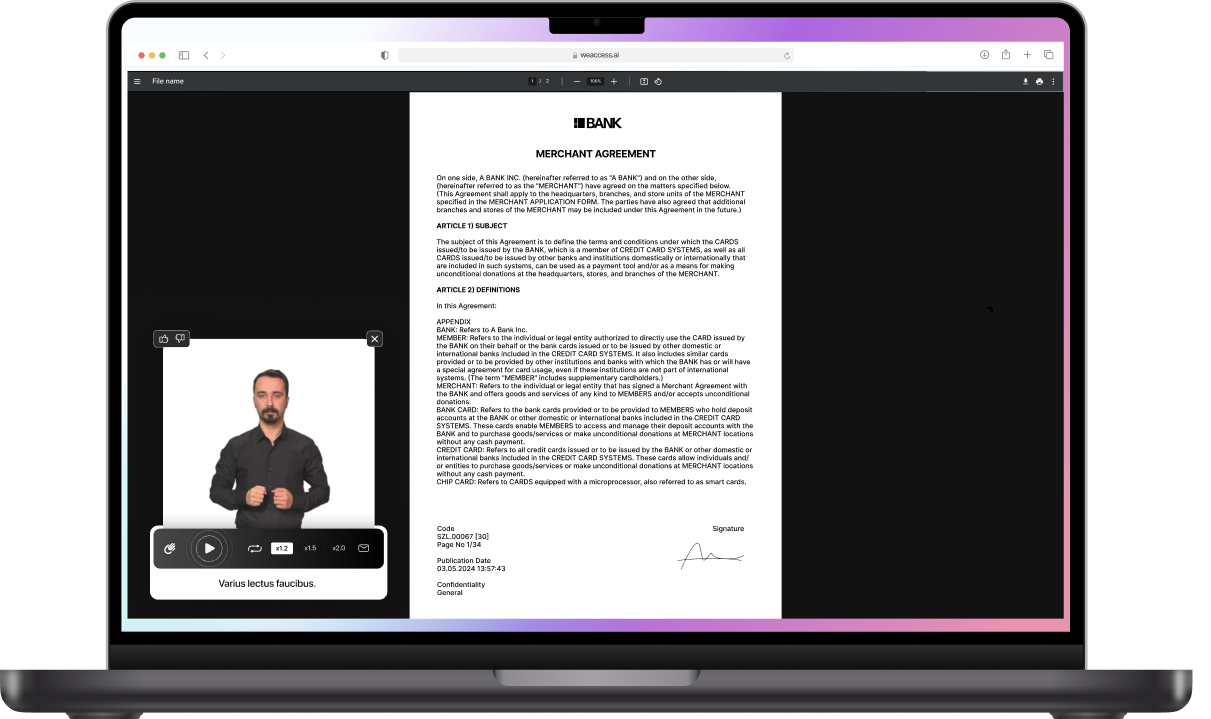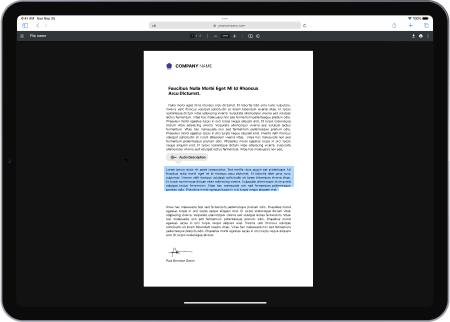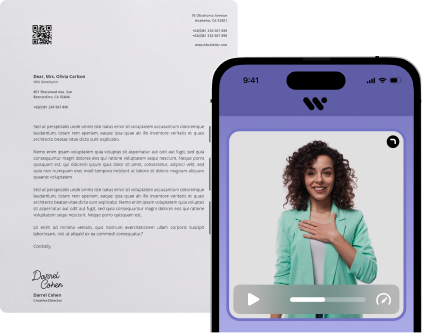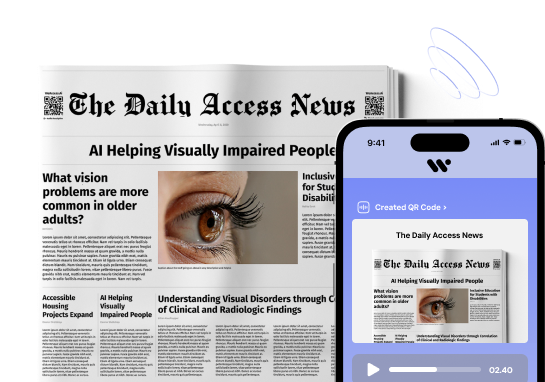Increasing Your Target Audience with Digital Accessibility: Reach More People
In life, things you never expected can bring you unexpected success. This is true in your daily In many cases, digital accessibility can have much more impact than you think. Even the smallest accessibility criteria you pay attention to on your website will greatly benefit disabled visitors to reach you. Undoubtedly, an e-commerce platform that wants to reach happy customers will want to offer more functional features on its website. Or a blog site owner who wants to reach loyal readers will definitely want their content to be accessible from every direction. One of the functional features that will bring you to your goals is digital accessibility.
In order to reach more people and in direct proportion to this, to get more happy customers or loyal readers, you should definitely include an end-to-end accessible experience among the functional features you will add to your website. In our article, we will discuss this issue in detail. We recommend you to read our article to the end for digital accessibility criteria, things to consider in this regard and much more.
Importance and Benefits of Digital Accessibility
Digital accessibility is of great importance for both companies and the people who use theservices offered by those companies. Similarly, digital accessibility provides many benefits not only for the users who visit a website, but also for your company that owns that website. Let's talk about them briefly.
The importance and benefits of digital accessibility for companies
Companies should always care about every cluster of society in order to get more customers or reach higher visitor numbers. Among these clusters, of course, are people with disabilities. If you provide the necessary accessibility features on your website for individuals with visual, hearing, and limb disabilities, these users will want to spend more time there when they visit your website.
Let's say you own an e-commerce website. Even if the products you offer for sale are more expensive compared to competing platforms, disabled customers may complete their shopping on your website due to the seamless experience they will get. No visually impaired person spends too much time on a web page where they have difficulty entering their credit card details while navigating with a screen reader. No hearing impaired person will try to shop on a website that does not use understandable expressions or does not include a sign language option in video expressions.
Another importance of digital accessibility for you is prestige. If you can tell people that you offer an accessible experience for disabled users on your website, this will attract everyone's attention and sensitive citizens who see that you care about disabled people will tend to visit your website and even shop there.
There are many other benefits of digital accessibility for your brand, but first and foremost, you should see an end-to-end accessible experience as part of social awareness and a responsibility to ensure everyone's right to information. Therefore, it is important that you ensure accessibility not by saving the day, but by giving importance to this issue in your business plan.
The importance and benefits of digital accessibility for disabled users
Providing digital accessibility criteria on your website makes life easier for disabled visitors. For example, if you use a design that is fully compatible with screen readers on your website, a visually impaired visitor can quickly navigate your website like a sighted individual.
Similarly, adding alt texts to the images on your website will make it easier for visually impaired people to understand what is in an image.
It is very important to work not only for individuals with no vision, but also for users with low vision. Including various high contrast themes on your website, placing shortcut keys that allow font size to be increased or decreased, and taking various other measures will contribute positively to the experience that low vision visitors get from your website.
For hearing impaired individuals, it will be very useful to use more understandable expressions in written texts, to include sign language in video content, and to include a live support specialist who knows sign language that hearing impaired users can easily communicate with. This issue is very important as access to digital content by hearing impaired individuals involves different difficulties.
The way for people with disabilities to quickly access the information they are looking for is through the implementation of inclusive accessibility policies. For this reason, it will be very useful for you to give importance to this issue within your company.
Fulfilling the Accessibility Needs of Disabled Users
Now we will take a more detailed look at the basic topic of "increasing audience through digital accessibility". Of course, if you want to reach more users by providing digital accessibility criteria, you first need to know what they are. Individuals with visual or hearing impairments need to be able to access content on digital platforms in an accessible way. Each type of disability is different, so content needs to be specifically optimized.
Creating User-Friendly Content for the Visually Impaired
There are different ways to create user-friendly content for visually impaired or low vision individuals. You need to work differently for your target audience who have no vision at all, i.e. who can only use products like computers and smartphones with screen reader software, and differently for people with low vision who use magnification tools built into operating systems or third-party magnification software. Of course, your work is also suitable for people who only need high-contrast viewing modes without the need for magnification software.
Low Vision Users
Include high-contrast theme options such as night mode or "black and white, white and black, black and green" on your website.
Add shortcuts to adjust the font size for text content. This way, people who need it can read your content more easily.
- If possible, use a simple interface mode on your website that is free of distracting elements for low vision users only.
- Design search boxes, subsections and other necessary areas on your website to accommodate magnification software. For example, the Windows Magnifier app should be able to follow the user as they type something. Developer APIs for this are shared by the respective platform developers.
Never Seen Users
Make sure that all buttons, menus and shortcuts on your website are labeled correctly.
Add appropriate alt texts to your images that do not contain alt text.
Design your website and the content on your site according to the appropriate heading system and fields. Use heading tags such as H1 and H2 where necessary and separate the lower part of the site from the main part (footer and header section).
Provide shortcuts for screen reader users to quickly navigate to the main part of the page when they are on any page (jump to main content shortcut).
If possible, provide audio description for video content.
Creating User-Friendly Content for Hearing Impaired Individuals
There are different ways to create accessible content for hearing impaired users. First of all, it is very important to use understandable language in written content.
If the content on your website is supported by video, there are 2 ways to make these videos accessible for hearing impaired individuals. The most widely used method, which is highly preferred due to the support of major video sharing networks such as YouTube, is to add subtitles to the videos. The subtitles you create will make it easier for the hearing impaired to understand the video content.
The second method is to add sign language for videos. Sign language is more widely used by the hearing impaired for communication today, so your videos will be more likely to be watched by the hearing impaired.
Implementation of Digital Accessibility Principles
Although there are many technical aspects of implementing digital accessibility principles, there are also practical considerations. Making digital content accessible to everyone is not limited to accessible web page design or videos with audio description or sign language options. The content also needs to be created in the right way. If your goal is to increase your audience through accessibility, it is important that you meet some basic criteria for digital accessibility that are relevant to everyone, not just users with disabilities. The following principles should be applied to make content understandable for everyone, not just visitors with disabilities.
Perceptibility Principle
Regardless of whether a user is visually or hearing impaired, what is included in any digital content should be easily perceivable with or without auxiliary accessibility tools. At this stage, it is important that a website or mobile application is designed correctly in terms of accessibility. However, in addition to this, the content should also be created correctly.
In this context, the answers to the following questions should be addressed for both the website and the content to be included in the website:
- Does the website or content contain elements that would distract a disabled user? For example, an irrelevant pop-up ad that appears to a visually impaired visitor while reading an article may make it difficult for them to perceive the page content with screen reader software or magnification software, because such components distract the visitor.
- Is the content on the website designed correctly? Even if it is written content, the design of some websites can prevent screen reader software from reading the content correctly. In addition, poorly designed paragraph and font formats can also make it difficult to perceive the content.
Understandability Principle
The comprehensibility of a piece of content is generally related to how it is constructed. The correct division of paragraphs, the thoughtful construction of sentences in a piece of content, the minimum amount of expression disorders, the correct use of headings and the cleanliness of the content are all important for the content to be easily understood by everyone. When it comes to "understandability" of a piece of content, questions such as:
- Do the text, buttons and other details in a web content contain expression disorders that prevent understanding of the content?
- Are the paragraphs in the content as long as they should be?
- Do the headings really help to understand the main points of the content?
- Does the relevant content contain repetitive sentences?
- Are the sub-texts or descriptions of the images in the relevant content selected correctly?
Especially the last 2 questions are very important for understanding the content. Repetitive sentences prevent a blog or news article from being easily understood. Having an image after every sentence in a piece of content and having the name of that image exactly the same as the sentence does great harm to the aesthetics of the content. Unfortunately, many popular news sites in Turkey today resort to such content editing methods that make it difficult to understand in order to get their content read more.
Website and Application Accessibility Improvements
We're getting to the heart of the matter, to reach more people we need to provide an accessible experience, but how? Of course, there are some things that need to be done for this, whether it's a website or a mobile app. These can be divided into technical improvements and content creation considerations.
Technical improvements are the design of the website or mobile applications in a way that is suitable for users with low vision or visual impairment. For this purpose, accessibility deficiencies in the website or mobile application are identified and design or coding deficiencies are resolved by the relevant teams.
The issues to be considered when creating content include studies that will make it easier for a disabled user to understand a content. Let's talk about these briefly.
Technical accessibility improvements for Website and Mobile Apps
Full screen reader compatibility for blind individuals
This process involves making all areas of the website or applications compatible with screen reader software. For this purpose, unlabeled buttons, unvoiced menus, components that will affect screen reader performance and other accessibility defects on the platform are identified and necessary changes are made to the application structure to resolve them.
Color Contrast and Visual Design for Low Vision Individuals
This process involves making changes that make it easier for people with low vision who do not need screen reader software to use an app or website. Many low vision users complain about the lack of high contrast color themes in the apps they use. In addition, the lack of options to change the font size on any website will prevent them from having a practical digital experience.
It is also important to note that apps and websites can make it difficult to focus on the actual content. In order to resolve all of these issues, it is first necessary to identify the components of the website or mobile application that may negatively affect the experience of individuals with low vision. In addition, various high-contrast theme options, font size adjustments and so on should be incorporated into the platform to facilitate their user experience. As a result of the software changes, users with low vision will be able to use the website or mobile application more easily.
Content Accessibility Improvements for Website and Mobile Apps
Use of Alternative Texts in Visuals
The ability of a visually impaired visitor to learn what is in an image in any content on your website depends on properly created alternative texts. For this reason, alt texts should be added to the images on your website that clearly explain what is in that image and, if important, include other details about the image.
Correct Content Curation
Content curation is also crucial for a more accessible web content experience. Some things to consider when creating content for visitors will positively affect everyone's experience.
First and foremost, if there are many headings and sub-headings in the content, it will be useful to include a "table of contents" in the relevant content so that a desired heading can be accessed quickly. Proper division of paragraphs, descriptive and clear headings, and avoiding the use of duplicate sentences and words in the content are very important for content accessibility.
Additional Accessibility Recommendations for Website and Mobile Apps
Keyboard Shortcuts for Websites and Mobile Screen Reader Gesture Compatibility Like everyone else, people with disabilities use many different devices for everyday tasks. Therefore, the experience of navigating a website needs to be the same for them on every device.
For desktop devices, it is important that the web page supports keyboard shortcuts. For this, buttons, links, list items and other elements on the website should be built in such a way that they are recognized by screen readers. Some studies may require technical improvements to the theme structure of the website.
The website should also be compatible with screen reader finger movements on mobile devices. In most cases, accessibility improvements will ensure compatibility for both platforms, but reviews should be conducted on each platform for a seamless user experience.
User Friendly Interfaces for Mobile Apps
Designing a really user-friendly interface for mobile applications is very important for you to get more target audience. For this reason, it is very important that a designed mobile app is understandable by everyone, that something can be easily found on the app and many other factors. Shortcuts to help people quickly find what they are looking for, help tips to guide them through the app, and other efforts to enhance the user experience are the golden key to a user-friendly mobile app. There is also a link between a user-friendly mobile app and an accessible experience.
Social Media and Digital Marketing Accessibility
In order to increase your target audience, the accessibility work you will do in your social media posts and advertising campaigns is also very important. These efforts will enable disabled social media users to get to know your products and you better, which will increase your number of interactions/following depending on your customers or targets. We have listed below what you should pay attention to in this regard.
Accessible Graphic and Visual Content
The visual content you share on social media networks such as Facebook, Twitter (now X), Instagram, etc. can be easily rendered in a way that visually impaired users can understand with the tools offered by these platforms. Facebook applications, X and LinkedIn offer the possibility to add alternative text for the images you add to your posts. In the alternative texts you add to the posts you share on these platforms, you can explain the relevant image and make it easier for a blind person to understand what you are sharing.
If the platforms' image alt-text fields are insufficient to add the image, you can write details about the image in the post text. Especially tables and graphical elements are more difficult to transcribe into text, so the features offered by social networks may not be sufficient for this type of content.
Subtitling and Hearing Impaired Friendly Apps for Video Content
You can add subtitles to the video content you share on social media platforms so that hearing-impaired individuals can understand the subject matter of the video. Nowadays, some content creators do this even if they don't realize its importance. On the other hand, if you're sharing a video on YouTube, your job is easier as the platform offers native support for subtitles.
While captioning is enough to make it easy to follow the content, if you want to offer a truly inclusive digital accessibility experience for the hearing impaired and attract more attention from the target audience, you should consider including sign language in your video content.
Digital Accessibility in Email Campaigns
Email campaigns are also very important for reaching more people, although they have become less effective with the proliferation of social media. Of course, there are some accessibility considerations here too. If you pay attention to these and manage to attract the attention of disabled consumers, you will get more customers.
First of all, it is important that all images in emails, including the company logo, contain alt text. Social media links, other clickable elements and text at the end of the email should also be designed to be accessible. It is quite common nowadays for people to delete an email as soon as they see it, due to the increase in spam emails and aggressive advertising policies of various companies, so it is important that email campaigns do not contain unnecessary components, are designed as simple as possible and do not bore the customer.
The Importance of Data Analysis and Feedback
You may think that you meet all the requirements for digital accessibility, whether on social networks, your website or mobile apps. However, the people who will test your experience will be the people who follow you on social media or use your website or mobile app. Their feedback is one of the clearest indicators of how successful you are in this regard.
For this reason, you should carefully analyze and evaluate feedback from users. For example, if a user has an accessibility problem while using your mobile app, you should support them and look for the source of the problem. The results you will reach in the light of this feedback will make a great contribution to improving accessibility.
On the other hand, it is very important to track user behavior through cookies in order to see and solve potential problems with your website or mobile app earlier. By analyzing crash reports, pages where a user spends too much time, and many other metrics, you can solve not only accessibility issues, but also many other problems that you may not have noticed before.
It is important to test the accessibility work you do on your website. At first, you should perform these tests in-house and analyze whether there is a possible technical problem. Then you should conduct the tests like an ordinary user.
In user testing, getting support from a visually impaired computer or smartphone user will allow you to understand how good your work really is. For this reason, if possible, you can include a visually and hearing impaired user experience specialist in your team or work with outsiders on a regular basis. In this way, you will certify your accessibility efforts.
Team Collaboration and Training
Team cooperation and training are of great importance for the digital accessibility process to progress steadily, to ensure its continuity and not to be constantly interrupted. It is essential for digital accessibility to be permanent that the units within the company work in coordination with each other and share information at regular intervals.
Information Sharing between Design and Development Teams
The user experience design team and the development team need to communicate with each other to ensure digital accessibility during the development of a mobile app or website. It is not enough for only one department to work on digital accessibility, in most cases the design and coding process is carried out together. Therefore, teams should constantly exchange information to avoid problems in the future.
This is also very important for maintaining accessibility in the future. If the parties do not pay due attention to the issue, a mobile application or website may lose the accessibility features it gains in the future.
Accessibility Trainings and Awareness Raising
The importance of digital accessibility is something that some software developers and designers are not aware of today. For this reason, various studies should be carried out to raise their awareness about digital accessibility.
For this purpose, it would be useful to plan training and seminar programs that your company employees can attend about what digital accessibility is and what it means for visually and hearing impaired individuals. In addition, software developers and web designers who are successful in the technical side of the business can also train the relevant teams in your company on digital accessibility, so it would be the right move to reach out to experts in their field.
Thanks to these efforts, all the staff working in your company will get to know what digital accessibility is and learn how to develop solutions in this regard.
Continuity in Digital Accessibility: Keep Yourself Updated
Monitoring Digital Accessibility Standards
WCAG 2.1, WIEK 2.0 and other accessibility standards are constantly being updated due to different technologies and developments over time. Naturally, you will want to update your website or mobile application according to the needs of the time.
In order to ensure permanent accessibility, it is important to keep up with developments in accessibility standards. In this way, you will have an idea about what to do about accessibility in the face of developing technology.
Keeping Up with Technological Developments
A company operating in the digital space must always keep up with technological developments. Most of the time, technological developments will be positive for you, and there may even be technologies that will enable you to facilitate accessibility processes in the future. For this reason, it is important to monitor technological developments and keep up with current trends in your website or mobile applications.
Otherwise, your competitors may use innovations before you and leave you behind in terms of usability, accessibility and much more. Keep up with technology for both a more accessible experience and survival.
Integrating Digital Accessibility Strategy with Audience Expansion
Strategy of Digital Marketing and Accessibility
Inclusion requires that not only your development teams but also the team managing your digital marketing strategy are aware of what they need to do in terms of digital accessibility. Your social media team should not only produce accessible content, but also occasionally share social media posts that cater to people with disabilities.
Content Production that Encourages Participation of Users with Disabilities
I'm sure you'd all like disabled users who visit your website or mobile app to share their opinions about your content. Like everyone else, they want to leave you feedback, but it's possible to do a few small things to encourage them to do so.
First and foremost, create accessible content, which by now you already know. You can also research what a piece of content means to someone with a disability and refer to it from time to time.
Also, supporting disability awareness events and campaigns, celebrating well-known days like World Disability Day, and much more will increase the number of feedback you receive from disabled visitors. In short, concretely show the importance you attach to people with disabilities in the content you publish and leave the rest to the users. Conclusion and Next Steps
Sustainability of Digital Accessibility
It is important to provide an accessible experience for everyone, but it is even more important that this accessible experience is sustainable. If even a small change to your app or website has a negative impact on users, it means you have problems maintaining accessibility.
You should plan the accessibility process in an ongoing, sustainable way, not with day-to-day efforts. You should examine how the slightest change you make will impact accessibility and, if necessary, complete the relevant accessibility work before making updates to your app or website. You should always be ready to deliver a fully accessible experience to consumers - that's sustainability.
Your Digital Accessibility Approach to Expand Your Audience
Your approach to digital accessibility is invaluable for expanding your audience. If you don't care about digital accessibility at all, you are not aiming to reach users with disabilities. If you are providing accessibility with day-to-day efforts, it shows that you only care about accessibility for the moment. But to reach more disabled users and expand your audience, you need to make accessibility an ongoing policy.
Remember, providing an accessible experience will not only increase the number of visitors with disabilities, but anyone who has a positive experience will recommend you to others and you will gain new customers or readers.
In our long content, we have discussed accessibility and target audience with you and explained how you can reach more people with your digital accessibility efforts. As WeAccess.Ai, we will continue to expand your horizons with different content.
Conclusion and Recommendations
In today's digital age, accessibility is not an option; it's a necessity. Ensuring digital accessibility on your website or mobile app is not only about complying with legal regulations but also about providing equal opportunities for all individuals to access and interact with your digital services. By prioritizing digital accessibility, you can enhance brand loyalty, acquire new customers, and strengthen your connection with existing customers. Remember, every interaction counts, and by making your digital services accessible, you can create a positive impact on your customers and your business as a whole.
You may be interested : Digital Accessibility and Competitiveness

